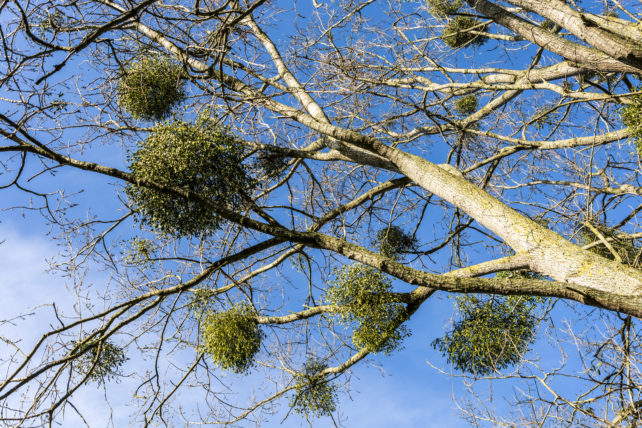Holiday favorite mistletoe – the kissing plant – hides a secret behind its romantic persona. It's actually a hemi-parasite that attacks living trees.
Phoradendron, a genus of mistletoe often used to decorate doors, aptly translates to Greek for "thief of the tree".
Descended from sandalwood, mistletoe has diversified into over a thousand global species.
While sandalwood sinks its own roots into the roots of other trees for nutrition, mistletoe takes parasitism in a different direction by infiltrating tree branches.
Reaching into the sky, it draws energy from the sap of its tree host and the Sun.

Mistletoe reached these heights of success by evolving to produce sticky seeds, packaged in tasty berries which are devoured by birds – up to 100 berries a day.
Coated with a clear substance called viscin, the sticky seeds are then defecated.
If a flying bird's gluey mistletoe poop is lucky enough to land on a tree, it clings to its branches, claiming it as its new host.
Sticky seeds and poop also hitchhike on a bird's feet, beaks, and butts.
Mistletoe causes stress to trees, making them more susceptible to insects and diseases, horticulturalist Allison Watkins from AgriLife Extension explains.
Although unlikely to kill a healthy tree, mistletoe can cause its limbs to die.
Mistletoe obtains water and nutrients from xylem – which takes water and minerals from the roots to the leaves of a plant – but it can also sneakily avoid a damaged tree's stress by consuming from the phloem, which transforms nutrition from the tree's leaves, instead.
Mistletoe can be toxic to people and pets, although Watkins says a small amount in well looked after gardens shouldn't cause concern.
But mistletoe has good qualities too.
To the plant's credit, it can show kindness by sharing a host tree with a mistletoe friend, increasing photosynthesis for nutrients, and causing less tree damage.
In many ecosystems, its flowers are nectar for honeybees, and it's a host plant for caterpillars. And damaged trees provide nesting cavities for critters like birds, bats, insects and even small mammals.
"Squirrels will also eat the berries, and deer and porcupines will eat the plant itself," says wildlife specialist Maureen Frank from AgriLife Extension.
Australian mistletoe is part of the management of the endangered Regent Honeyeater (Anthochaera phrygia), who need it for food and shelter.
The dense foliage is a welcome shade for many animal species, especially in arid regions.
Perhaps best of all, mistletoe also offers us a lighthearted way to connect with loved ones at Christmas.
